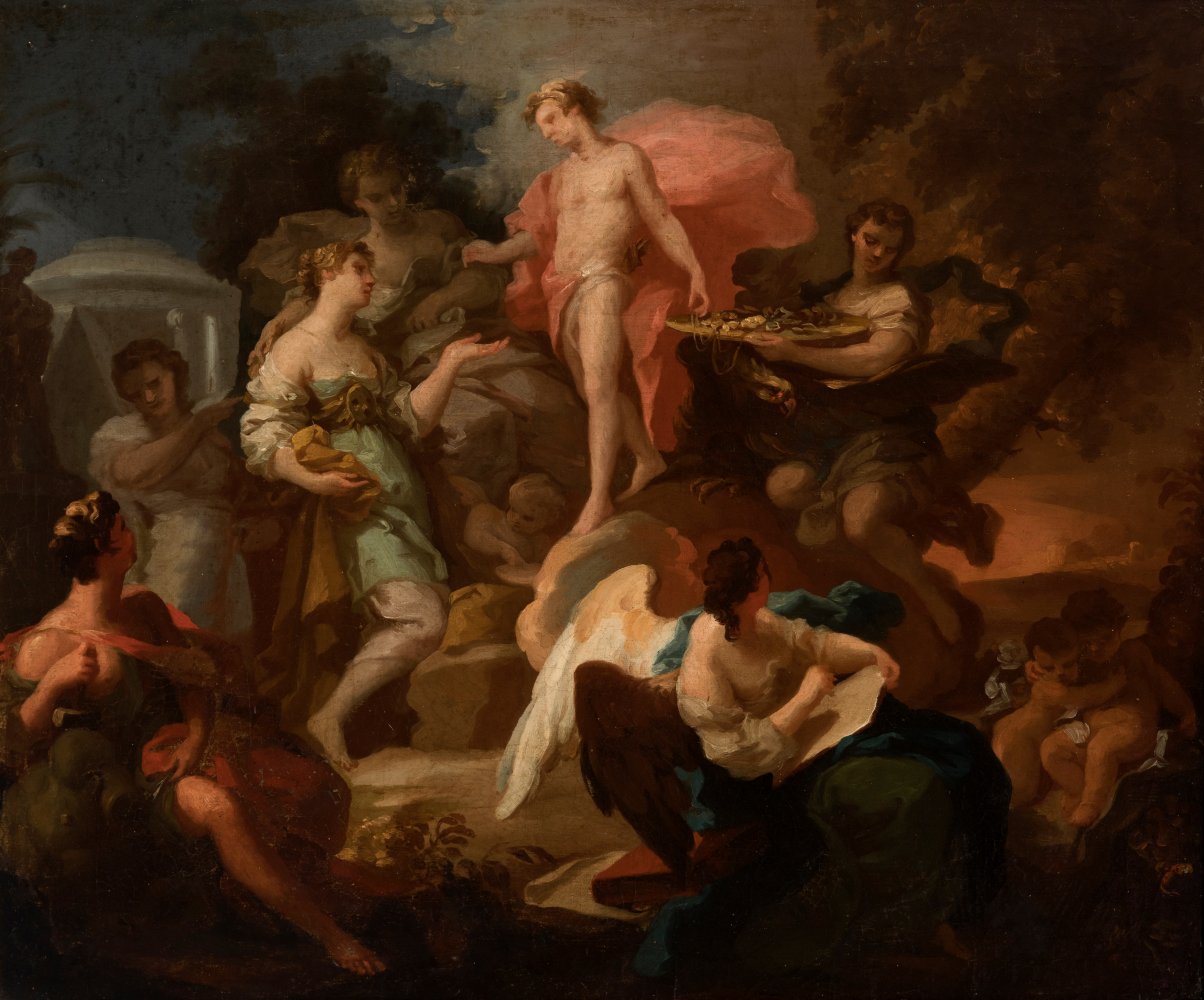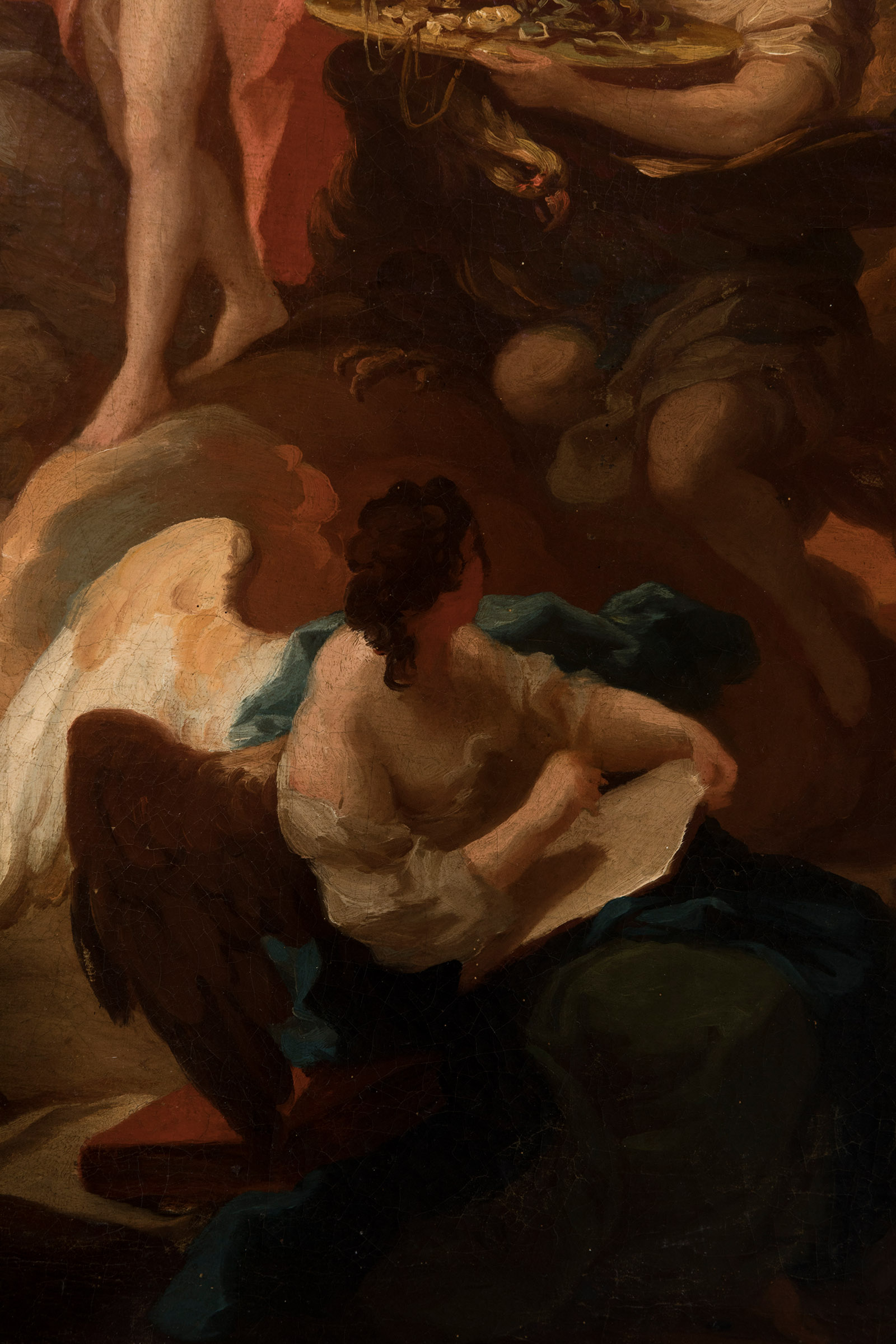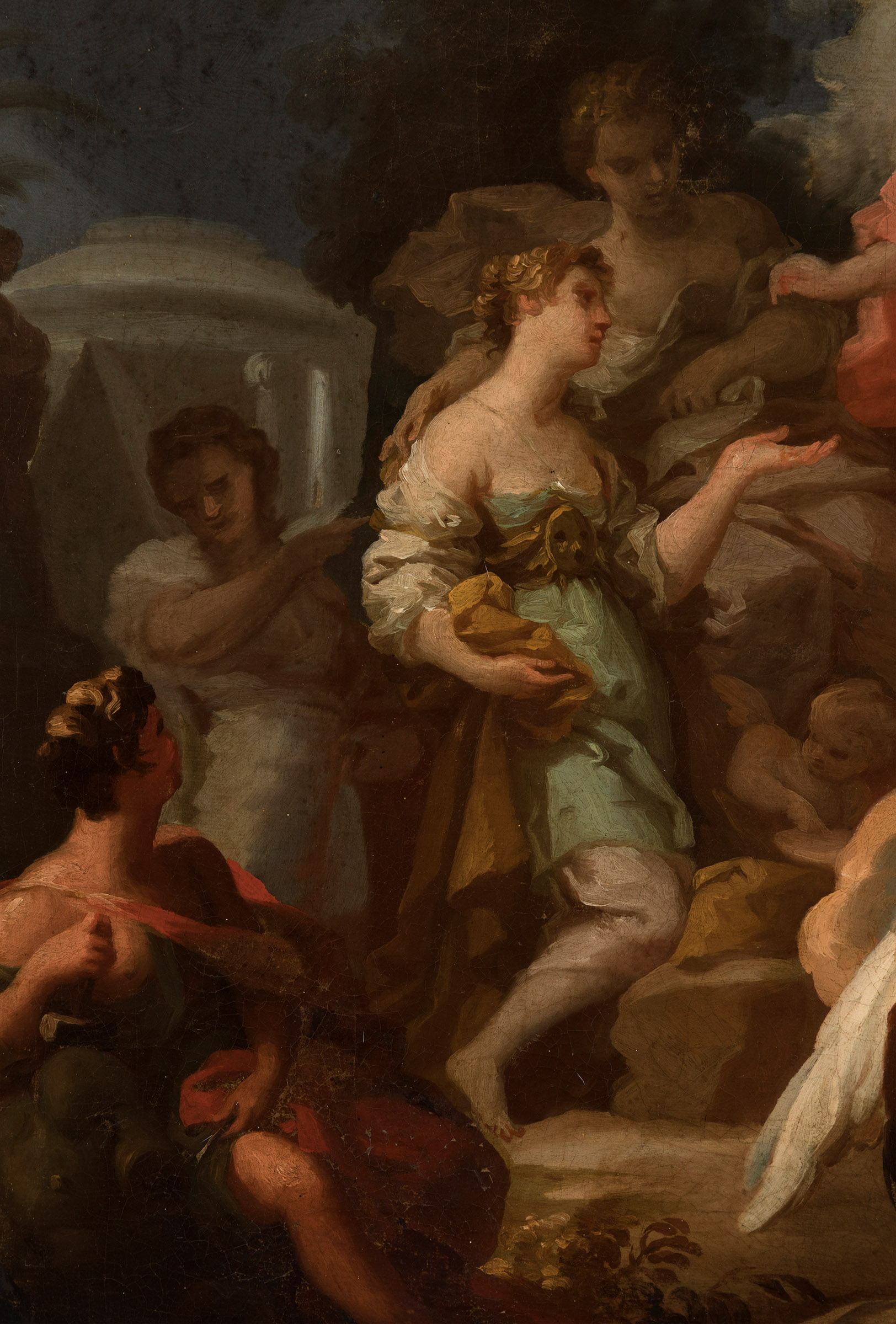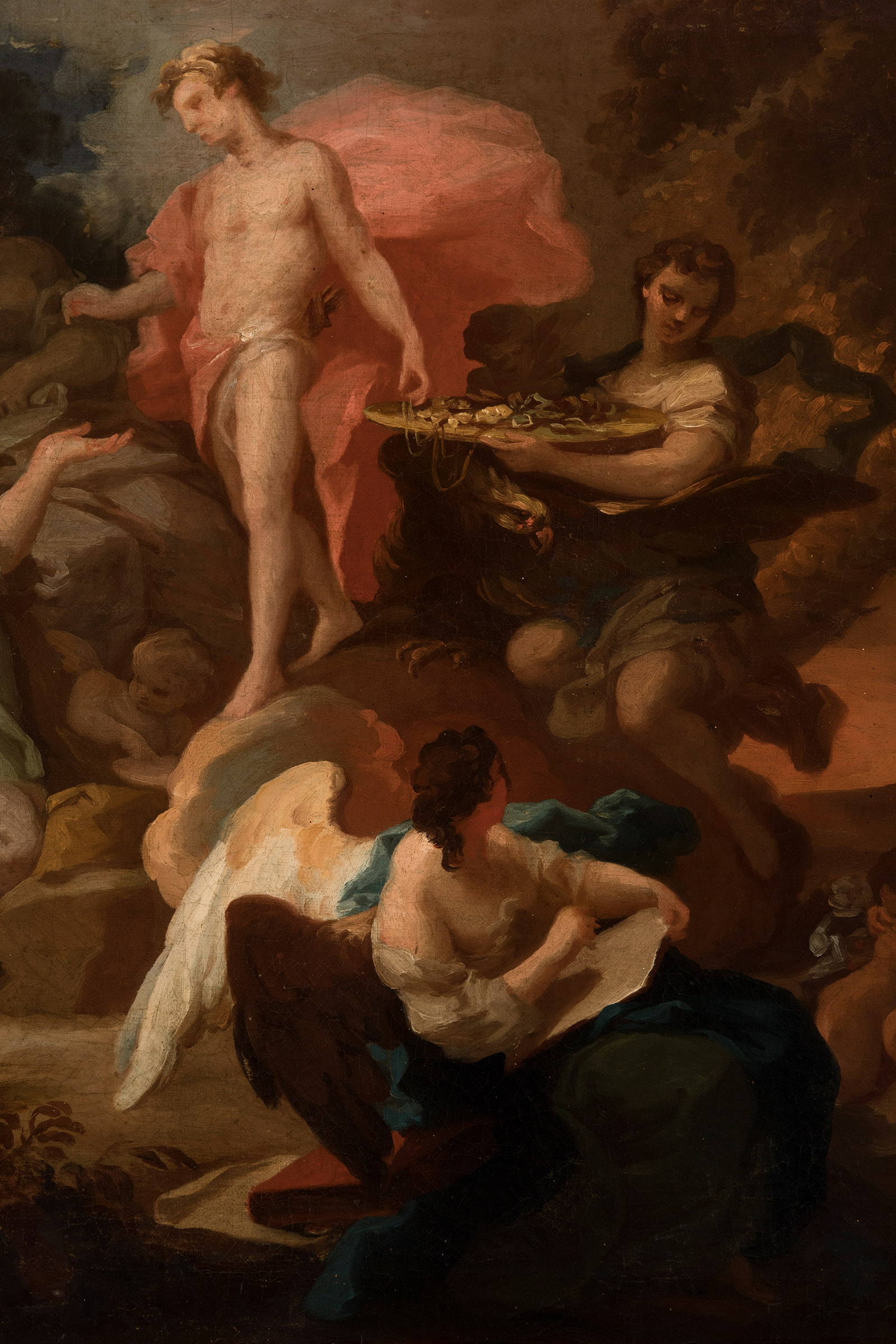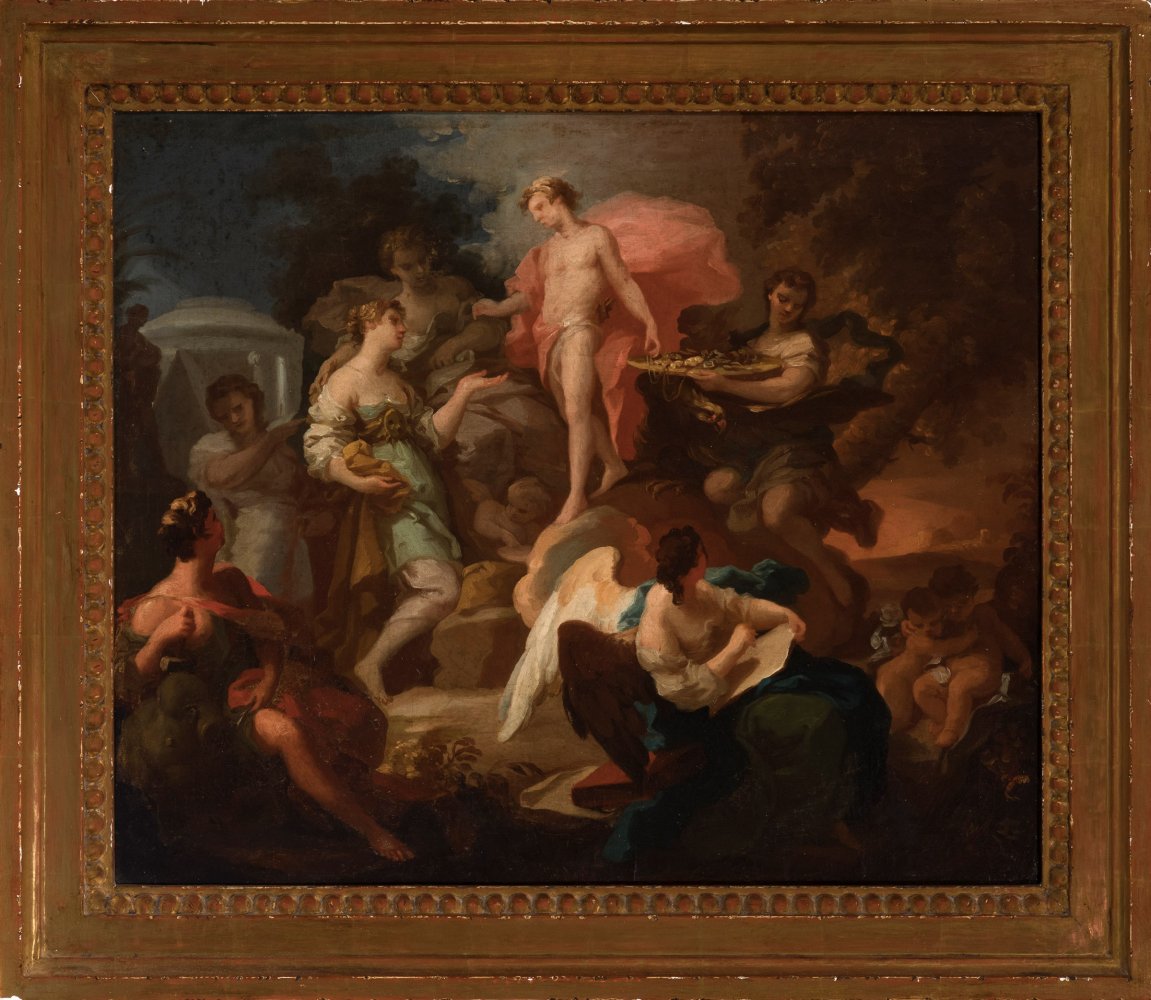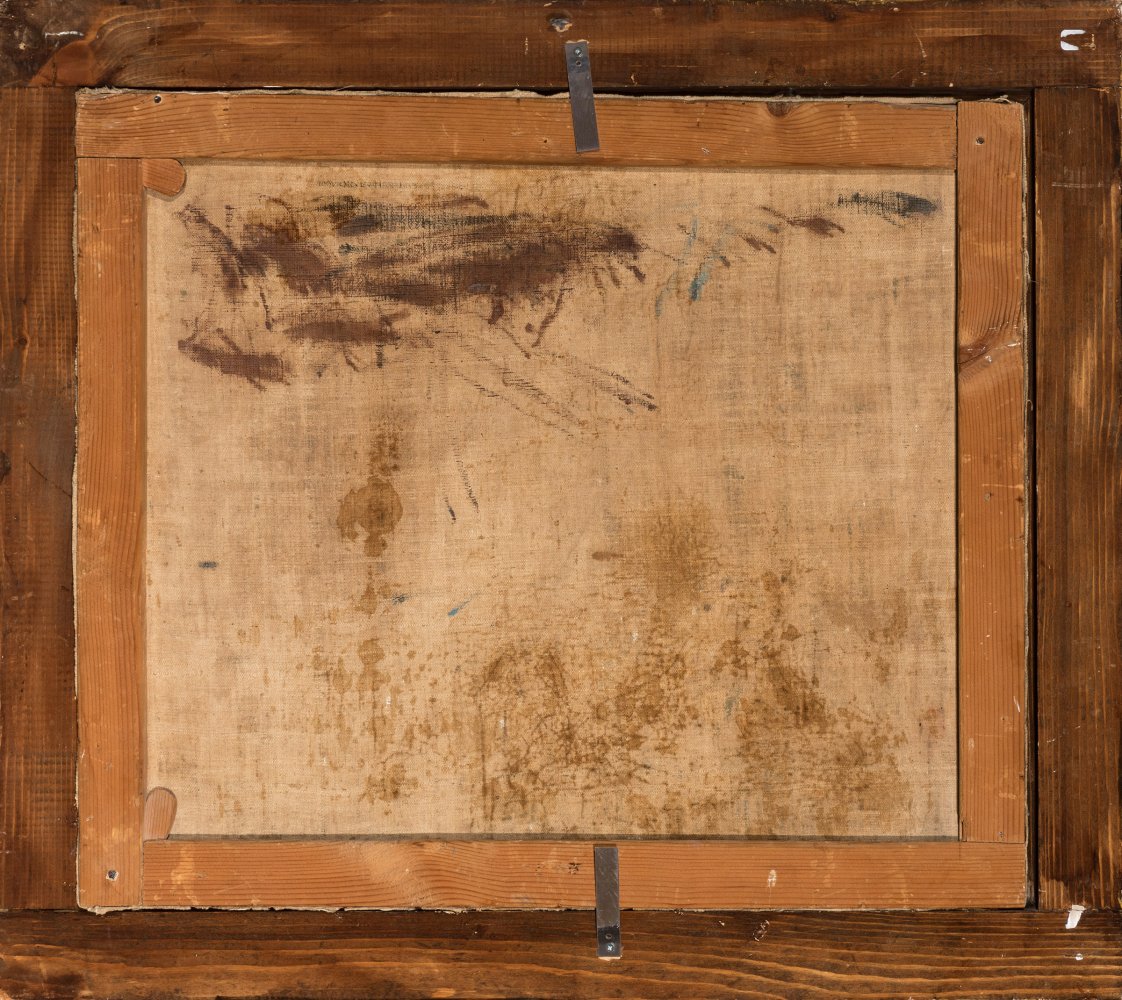57
Attributed to CORRADO GIAQUINTO (Italy, 1703 - 1765/66)."Apollo rewarding the arts (Allegory of
"Apollo rewarding the arts (Allegory of the monarchy as patrons of the arts)".
Oil on canvas. Re-drawn in the 19th century.
It presents restorations.
Measurements: 50 x 60,5 cm.
The preparatory oil sketch shown here was intended for a decoration that no longer exists in the Royal Palace. The work shows Apollo, a figure representing the Spanish monarchy, rewarding with treasures the figures representing painting, architecture and sculpture. On the lower right the figure of History, winged but with her foot firmly on the ground, records the scene for posterity. The role of the king as the architect of peace and prosperity within his kingdom was emphasised throughout the complex iconographic programme of decoration, written for the New Royal Palace in 1748 by Father Martin Sarmiento.
Due to its formal characteristics, the present work is attributed to Corrado Giaquinto, an Italian painter of the 18th century who is considered to be the greatest representative of Rococo painting in Rome at the time. Owing to his compositional mastery and masterful use of colour, the Italian artist became a point of reference for several generations of Spanish painters. We can see how the saint, dressed in her characteristic Dominican habit, kneels before the vision of the risen Christ. A leading representative of Rococo painting in Rome in the first half of the 18th century, Giaquinto's work was a point of reference for several generations of Spanish painters. Appointed painter to Ferdinand VI in 1753 and until 1762, he was also artistic director of the Royal Tapestry Factory of Santa Barbara and director general of the San Fernando Royal Academy of Fine Arts. His language, which began with rococo and evolved in an increasingly classical direction, is characterised by a great sense of scenography and chromatic subtleties of extraordinary beauty. These two features are clearly evident here; the composition is totally theatrical, with the clarity of classicism combined with the elegant and graceful dynamism of rococo. The stage is organised in depth, playing with the position of the cumulus clouds and seeking a naturalistic representation of the space, with a sense of scenography inherited from the Baroque period. Giaquinto's is a classically influenced rococo, and his works will increasingly denote a more solid classicism: compositions of greater spatial clarity, as we see here, populated by solemn figures with lively gestures. However, this work is also related to Giaquinto because of its subject, which can be directly related to the work by his hand entitled "The Holy Trinity, the Virgin and Saints", painted between 1755 and 1756 and now in the Museo del Prado. In this work by the master, the format changes to landscape in order to include a larger number of figures: the saints John, the Fathers of the Church and several other saints. Furthermore, in Giaquinto's work Jesus and God the Father appear crowning the Virgin, a detail that is omitted here. However, even the composition of the oil painting presented here shows a knowledge of Giaquinto's work, with the same closed arched structure in the upper part, the gradation of light, the golden light in the upper part, etc. Giaquinto's "The Holy Trinity, the Virgin and Saints" is a sketch for the dome of the Royal Chapel in the New Palace in Madrid.
"Apollo rewarding the arts (Allegory of the monarchy as patrons of the arts)".
Oil on canvas. Re-drawn in the 19th century.
It presents restorations.
Measurements: 50 x 60,5 cm.
The preparatory oil sketch shown here was intended for a decoration that no longer exists in the Royal Palace. The work shows Apollo, a figure representing the Spanish monarchy, rewarding with treasures the figures representing painting, architecture and sculpture. On the lower right the figure of History, winged but with her foot firmly on the ground, records the scene for posterity. The role of the king as the architect of peace and prosperity within his kingdom was emphasised throughout the complex iconographic programme of decoration, written for the New Royal Palace in 1748 by Father Martin Sarmiento.
Due to its formal characteristics, the present work is attributed to Corrado Giaquinto, an Italian painter of the 18th century who is considered to be the greatest representative of Rococo painting in Rome at the time. Owing to his compositional mastery and masterful use of colour, the Italian artist became a point of reference for several generations of Spanish painters. We can see how the saint, dressed in her characteristic Dominican habit, kneels before the vision of the risen Christ. A leading representative of Rococo painting in Rome in the first half of the 18th century, Giaquinto's work was a point of reference for several generations of Spanish painters. Appointed painter to Ferdinand VI in 1753 and until 1762, he was also artistic director of the Royal Tapestry Factory of Santa Barbara and director general of the San Fernando Royal Academy of Fine Arts. His language, which began with rococo and evolved in an increasingly classical direction, is characterised by a great sense of scenography and chromatic subtleties of extraordinary beauty. These two features are clearly evident here; the composition is totally theatrical, with the clarity of classicism combined with the elegant and graceful dynamism of rococo. The stage is organised in depth, playing with the position of the cumulus clouds and seeking a naturalistic representation of the space, with a sense of scenography inherited from the Baroque period. Giaquinto's is a classically influenced rococo, and his works will increasingly denote a more solid classicism: compositions of greater spatial clarity, as we see here, populated by solemn figures with lively gestures. However, this work is also related to Giaquinto because of its subject, which can be directly related to the work by his hand entitled "The Holy Trinity, the Virgin and Saints", painted between 1755 and 1756 and now in the Museo del Prado. In this work by the master, the format changes to landscape in order to include a larger number of figures: the saints John, the Fathers of the Church and several other saints. Furthermore, in Giaquinto's work Jesus and God the Father appear crowning the Virgin, a detail that is omitted here. However, even the composition of the oil painting presented here shows a knowledge of Giaquinto's work, with the same closed arched structure in the upper part, the gradation of light, the golden light in the upper part, etc. Giaquinto's "The Holy Trinity, the Virgin and Saints" is a sketch for the dome of the Royal Chapel in the New Palace in Madrid.
26th October - Old Masters
Sale Date(s)
Venue Address
General delivery information available from the auctioneer
Setdart offers Worldwide shipping
PICK UP IN ROOM: You can come and pick up your lots in our offices (Barcelona, Madrid or Valencia). At the moment of the withdrawal, you will be able to accept the current conditions of the lot by means of a document that you will sign.
YOU CAN SEND ANOTHER PERSON TO PICK UP: This person must present a signed authorization that you can find in our web page by accessing from BUY AT SETDART- LOGISTICS-DOWNLOAD AUTHORIZATION DOCUMENT. You can also send an e-mail with the requested data in AUTHORIZATION DOCUMENT to admin@setdart.com
Important Information
25% buyer´s premium
21% buyer´s premium at www.setdart.com
Terms & Conditions
The maximum period to pay the lots is 7 working days. You can pay either via bank transfer or with credit card through our platform www.setdart.com (we only accept VISA or Mastercard).
BUYER´S PREMIUM: 22% Hammer price + 21% VAT from the buyer´s premium
If your piece has more than 100 years, our Ministry of Culture requires an export certificate in order for the piece to leave the country. Note that if the piece goes inside the EU, there is no cost for the export certificate. If the piece goes outside the EU, there is a cost for the export certificate. You can find more information in our Ministry of Culture website: https://www.culturaydeporte.gob.es/en/cultura/patrimonio/exportacionimportacion/exportacion/tasas.html
INQUIRIES: admin@setdart.com
Setdart guides you through the entire process, from the time of award to the day you receive your lot. Our logistics team will be happy to manage your transport, and will advise you on the best shipping method with professionals from the sector used to handling works of art and jewelry.
WE OFFER WORLDWIDE DOOR TO DOOR SHIPPING
PICK UP IN ROOM: You can come and pick up your lots in our offices. At the moment of the withdrawal, you will be able to accept the current conditions of the lot by means of a document that you will sign.
YOU CAN SEND ANOTHER PERSON TO PICK UP: This person must present a signed authorization that you can find in our web page by accessing from BUY AT SETDART-LOGISTICS-DOWNLOAD AUTHORIZATION DOCUMENT. You can also send an e-mail with the requested data in AUTHORIZATION DOCUMENT to admin@setdart.com
SETDART IS NOT RESPONSIBLE FOR THE STATE OF THE PARTS ONCE THEY LEAVE OUR FACILITIES. MRW SHIPMENTS: Once the payment is made, your lot will be packed for shipment, the logistics department will send you an e-mail notifying you of the day it leaves our warehouse, changes of address cannot be made after receiving this e-mail.
INSURANCE INCIDENTS: Coverage for the value of the auction up to 3000 ? per shipment, if the value of the auction is higher, Setdart will send you a quote including the additional insurance. The insurance company WILL NOT BE RESPONSIBLE FOR THE SHIPMENT THAT EXCEEDS THAT AMOUNT AND IS NOT FULLY INSURED. MRW INCIDENTS: Maximum notification 48 hours after receipt, after which the insurance company WILL NOT BE RESPONSIBLE AND NO CLAIMS WILL BE ACCEPTED.
E-MAIL LOGISTICS: logistica@setdart.com
PICK UP YOUR MESSAGES: You can send your own messaging, prior notice via e-mail that your shipment is ready, please note 3 or 4 days in advance. This type of shipment is packaged so Setdart will provide you with a quote.
EXPENSES FOR STORAGE: We inform you that if the purchased lot is not picked up within a month, you will be charged 30€ per week per lot. Setdart Online S.L., owner of the web site "setdart.com", "setdart.net" and "setdart.org", acts as a company of Spanish nationality inscribed in the Volume 36955, sheet 182, page B-293056 of the Mercantile Registry, with registered office at Calle Aragó













